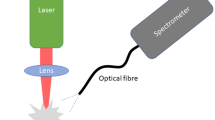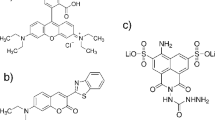Abstract
An acoustic technique developed earlier was applied to measure the molar number of fragments produced in the XeCl-laser-induced gas-phase photolysis of Cr(CO)6 and Mo(CO)6. The bluish-green Cr and Mo emissions were also monitored and correlated with the acoustic signal. For laser fluence ranging up to about 25 mJ/cm2 (38 mJ/cm2), the Cr (Mo) optical signal varied with laser fluence asy =dx 3, in agreement with the model that highly excited metal atoms were produced by direct three-photon processes. The acoustic signal varied with fluence asy = ax + bx 2, consistent with the model that most fragments were formed via sequential and direct two-photon processes. Quite expectedly, all coefficientsa,b andd vary linearly with carbonyl partial pressure. Both optical and acoustic signals showed onset of saturation at ≈ 25 mJ/cm2 (38 mJ/cm2) for the case of chromium (molybdenum) hexacarbonyl, suggesting that all photolysis channels were equally affected by the depletion of parent molecules. By assuming a common depletion mechanism, upper limits on the branching ratios of the various photolysis channels were estimated.
Similar content being viewed by others

References
M.A. Aylett: Chemtronics1, 146 (1986)
K.A. Gesheva, T.A. Krisov, U.I. Simkov, G.D. Beshkov: Appl. Surf. Sci.73, 86 (1993)
N. Okada, Y. Katsumura, K. Ishigure: Appl. Phys. A58, 99 (1994)
J.P. Herman; Chem, Rev,89, 1323 (1989)
D.J. Erlich, R.M. Osgood Jr., T.F. Deutsch: J. Electrochem, Soc.128, 2039 (1981)
T.M. Mayer, G.J. Fisanick, T.S. Eichelberger IV: J. Appl. Phys.53, 8462, (1982)
R. Solanki, P.K. Boyer, G.J. Collins: Appl. Phys. Lett.41, 1048 (1982)
D.K. Flynn, J.I. Steinfeld, D.S. Sethi: J. Appl. Phys.59, 3914 (1986)
H. Yokoyama, F. Uesugi, S. Kishida, K. Washio: Appl. Phys. A37, 25 (1985)
L. Konstantinov, R. Nowak, P. Hess: Appl. Phys. A47, 171 (1988)
R. Alexandrescu, A. Andrei, I. Morjan, S. Mulenko, M. Stoica, I. Voicu: Thin Solid Films218, 68 (1992)
G.W. Tyndall, R.L. Jackson: J. Am. Chem. Soc.109, 582 (1987)
G.W. Tyndall, R.L. Jackson: J. Chem. Phys.89, 1364 (1988)
G.W. Tyndall, R.L. Jackson: J. Chem. Phys.91, 2881 (1989)
G.W. Tyndall, R.L. Jackson: J. Phys. Chem.95, 687 (1991)
E. Weitz: J. Phys. Chem.91, 3945 (1987) and references therein
T.R. Fletcher, R.N. Rosenfeld: J. Am. Chem. Soc.105, 6358 (1983)
D.M. Rayner, Y. Ishikawa, C.E. Brown, P.A. Hackett: J. Chem. Phys.94, 5471 (1991)
Z. Karny, R. Naaman, R.N. Zare: Chem. Phys. Lett.59, 33 (1978)
M.A. Duncan, T.G. Dietz, R.E. Smalley: Chem. Phys.44, 415 (1979)
D.P. Gerrity, L.J. Rothberg, V. Vaida: Chem. Phys. Lett.74, 1 (1980)
G.J. Fisanick, A. Gedanken, T.S. Eichelberger IV, N.A. Kuebler, M.B. Robin: J. Chem. Phys.75, 5215 (1981)
N. Mikami, R. Ohki, H. Kido: Chem. Phys.127, 161 (1988)
W.R. Peifer, J.F. Garvey, R.L. DeLeon: J. Phys. Chem.96, 6523 (1992)
N.H. Cheung, E.S. Yeung: Chem. Phys. Lett.189, 164 (1992)
G. Chen, E.S. Yeung: Anal. Chem.60, 2258 (1988)
After the valve of the sample reservoir was open, it took few tens of minutes for the carbonyl partial pressure in the gas cell to reach the equilibrium vapor pressure of 0.16 Torr and 0.10 Torr for Cr(CO)6 and Mo(CO)6 respectively. Carbonyl partial pressure was measured to be about 60% of the equilibrium value when the sample valve was opened for 10 min
The value of the absorption cross-section σ at 308 nm was recalculated using the absorbance data of [8] and a Cr(CO)6 vapor pressure of 0.16 Torr. This value of σ is about 1.9 times larger than that given in Ref. [8]. It is noteworthy that the value of σ at 248 nm was also reported in Ref. [13] to be about 1.7 times larger than the corresponding value given in Ref. [8]
The respective dissociation energiesD n (n = 1,2,3) for breaking the first three metal-ligand bonds of Mo(CO)6 were recently measured to be 35,27, and 31 kcal/mol by J.A. Ganske, R.N. Rosenfeld: J. Phys. Chem.93, 1959 (1989).D n (n = 4,5,6) were reported to be 31, 29.5, and 40 kcal/mol, respectively in Ref. [18]. Therefore, three 308 nm photons of 12.1 eV total are just enough to break all six bonds (8.4 eV) and excite the Mo(I) atom to itsz 5 P 0 state (3.6 eV)
Our estimate of σ for Mo(CO)6 at 308 nm is about half that given in Ref. [8]. We should also point out that the value of σ at 248 nm reported in Ref. [15] is also about two times smaller than that given in [8]
Based on energetic considerations Ref. [29]
B. Venkataraman, H. Hou, Z. Zhang, S. Chen, G. Bandukwalla, M. Vernon: J. Chem. Phys.92, 5338 (1990)
Author information
Authors and Affiliations
Rights and permissions
About this article
Cite this article
Chan, C.W., Cheung, N.H. Pulsed-laser photolysis of chromium and molybdenum hexacarbonyls at 308 nm: Simultaneous monitoring of optical and acoustic emissions. Appl. Phys. B 61, 515–523 (1995). https://doi.org/10.1007/BF01081283
Received:
Accepted:
Issue Date:
DOI: https://doi.org/10.1007/BF01081283



